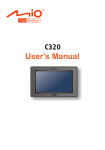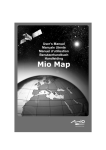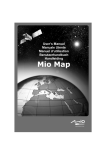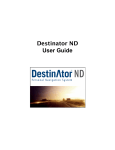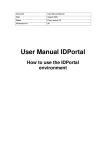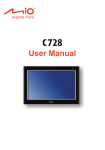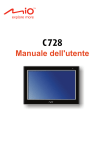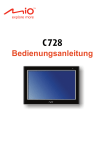Download User's Manual Manuale Utente Manuel d'utilisation
Transcript
User’s Manual Manuale Utente Manuel d’utilisation Benutzerhandbuch Handleiding English Mio Map User’s Manual R01 September 2004 English Trademarks All brand and product names are trademarks or registered trademarks of their respective companies. Note The information in this manual is subject to change without notice. English 0 Table of Contents Preface.................................................................................................... iv 1 Mio Map Installation ......................................................................... 1 1.1 Installing Mio Map Console.................................................................... 1 1.2 Installing and Activating Mio Map (Select Models Only) ....................... 2 1.3 Installing the Map(s) .............................................................................. 2 2 Mio Map Overview ............................................................................ 5 2.1 2.2 2.3 2.4 Mio Map Features.................................................................................. 5 Mio Map Hot Keys ................................................................................. 6 Starting Mio Map.................................................................................... 7 Mio Map Screen..................................................................................... 8 Map, Buttons, and Menus...................................................................... 8 Dragging the Map .................................................................................. 8 Zooming the Map................................................................................... 9 2.5 Quitting Mio Map.................................................................................... 9 3 Basic Navigation ............................................................................ 11 3.1 Selecting an Origin .............................................................................. 11 3.2 Selecting a Destination ........................................................................ 11 Using Address...................................................................................... 12 Using Point of Interest (POI)................................................................ 14 Using Favorites.................................................................................... 16 Using History........................................................................................ 18 Using Outlook Contacts ....................................................................... 19 Using Map Cursor................................................................................ 20 3.3 Navigational Aids ................................................................................. 21 Calculating a Route ............................................................................. 21 Recalculating the Route....................................................................... 22 3.4 Show Route ......................................................................................... 23 3.5 Cancel Route ....................................................................................... 23 i English 4 More Navigation Features............................................................. 25 4.1 Avoid Roads......................................................................................... 25 Creating a List of Roads to Avoid ........................................................ 25 Selecting the Roads to Avoid............................................................... 28 4.2 Favorites and Auto Alerts..................................................................... 29 Creating Favorites or Auto Alerts......................................................... 29 Configuring Auto Alert Category .......................................................... 31 Managing Favorites ............................................................................. 31 4.3 History .................................................................................................. 33 4.4 Records................................................................................................ 34 Recording a Journey............................................................................ 34 Playing a Recording............................................................................. 34 Deleting a Recording ........................................................................... 35 4.5 Trip Planner.......................................................................................... 36 Part 1. Select Planner Mode ................................................................ 36 Part 2. Manually Select the Origin ....................................................... 36 Part 3. Set Waypoints .......................................................................... 37 Part 4. Calculate the Route.................................................................. 39 5 Changing Map Views..................................................................... 41 5.1 Types of View....................................................................................... 41 2D View................................................................................................ 41 3D View................................................................................................ 42 Bird’s-eye View .................................................................................... 42 5.2 View the Route..................................................................................... 43 Turn by Turn......................................................................................... 43 Driving Direction................................................................................... 43 5.3 Day/Night Color Skin............................................................................ 44 Day Color Skin ..................................................................................... 44 Night Color Skin ................................................................................... 45 6 Options, Settings, and Preferences ............................................. 47 6.1 6.2 6.3 6.4 6.5 6.6 7 General Settings .................................................................................. 47 Map Settings ........................................................................................ 48 Route Settings ..................................................................................... 49 Alert Settings........................................................................................ 50 GPS Status .......................................................................................... 51 Look and Feel ...................................................................................... 51 Using Mio Map Console ................................................................ 53 7.1 Creating Your Own Maps by Map Cutting ........................................... 53 Part 1. Load the Map ........................................................................... 53 Part 2. Select the Area to Cut .............................................................. 55 ii English 7.2 7.3 7.4 7.5 7.6 Part 3. Save the Cut Map .................................................................... 59 Creating Your Own Maps by Route Cutting ........................................ 61 Installing Newly Created Maps to Pocket PC ...................................... 62 Removing Maps................................................................................... 63 Installing Mio Map to Your Pocket PC ................................................. 64 Using Favorites Importer ..................................................................... 65 iii English 1 Preface Precautions and Notices For your own safety, do not operate the controls of the product while driving. Use this product prudently. The product is intended to be used only as a navigation aid. It is not for precise measurement of direction, distance, location or topography. The calculated route is for reference only. It is the user’s responsibility to follow the traffic signs and local regulations along the roads. When you get off the car, do not leave your Pocket PC on the dashboard that is subject to direct sunlight. The overheating of the battery can cause malfunction and/or danger. GPS is operated by the United States government, which is solely responsible for the performance of GPS. Any change to the GPS system can affect the accuracy of all GPS equipments. GPS satellite signals cannot pass through solid materials (except glass). When you are inside a tunnel or building, GPS positioning is not available. A minimum of 4 GPS satellite signals is needed to determine current GPS position. Signal reception can be affected by situations such as bad weather or dense overhead obstacles (e.g. trees and tall buildings). iv English About This Manual This manual assumes that you are familiar with basic Pocket PC operations. If not, refer to the User’s Manual of your Pocket PC and familiarize yourself with the basic operations. This manual contains the following chapters: Chapter 1, Mio Map Installation, guides you through the installation process. Chapter2, Mio Map Overview, introduces the features of Mio Map, tells you how to start Mio Map, and provides a quick glance of the screen elements. Chapter 3, Basic Navigation, gets you started with the navigation function. Chapter 4, More Navigation Features, provides information on advanced navigation features. Chapter 5, Changing Map Views, introduces the ways you can view the map. Chapter 6, Options, Settings, and Preferences, tells you how to customize Mio Map for your personal likes and needs. Chapter 7, Using Mio Map Console, gives information on the Mio Map Console features such as cut map and find map. v English Terminology Get familiar with some terminology used by Mio Map and you are ready to start. GPS GPS (Global Positioning System) is a “constellation” of 24 well-spaced satellites that orbit the Earth and make it possible for vehicles/people/assets enabled with GPS receivers to pinpoint their location. Route Route is a course calculated by Mio Map, starting from the origin to the destination. Origin Origin is your starting point for a route. It is either your GPS position or a location selected by you on the map. Destination Destination is your end point for a route. Destinate Destinate is the command that you use to select a location on the map. There are several ways you can select a location. Navigation Navigation is the process where Mio Map leads you from your origin to your destination. Navigate Navigate is the command that you use, after determining the origin and destination, to calculate a route and start navigation. Navigation mode vs. Planner mode Mio Map can operate in either of the two modes: Navigation Mode This is the default mode of operation. In this mode, GPS positioning is on. A blue route with moving arrow shows your progress. Planner Mode In this mode, GPS positioning is off. Mio Map displays planned calculated routes, but not your progress. vi English 1 Mio Map Installation The Mio Map installation process includes two to three parts: first, installing the Mio Map Console on your desktop computer; second, installing Mio Map to your Pocket PC (for models without pre-installed Mio Map); and third, installing the map(s) to your Pocket PC. NOTE: Make sure that you have already performed the initial startup of your Pocket PC and set up a partnership with your desktop computer using Microsoft ActiveSync. (See the Quick Start Guide or User’s Manual of your Pocket PC for instructions.) 1.1 Installing Mio Map Console Mio Map Console is a tool for you to easily install software, install/remove maps, cut maps, etc. 1. Insert Mio Map Disk 1 CD into your desktop computer’s CD-ROM drive. The wise installer screen appears automatically. (If it does not appear, double click the InstConsMioA.EXE or InstConsMioE.EXE file on the CD.) 2. Select your language preference for the installation procedure and click OK. 3. Follow the onscreen instructions to select a destination location (default directory is recommended). 4. Select the language(s) that you want available for both the Mio Map Console on your desktop computer and the Mio Map to be installed in your Pocket PC. With the language(s) you want highlighted, click Next. 5. Follow the onscreen instructions to complete the installation. A status window indicates the progress of the installation. 6. Click Finish to exit installer program. 1 English 1.2 Installing and Activating Mio Map (Select Models Only) Depending on the model you purchased, the Mio Map software may have been pre-installed in your Pocket PC. If your model doesn’t have Mio Map pre-installed, you must install and Activate Mio Map by yourself. (See section 7.5 for information.) 1.3 Installing the Map(s) You must install the map(s) that you want before you can use the navigation function of Mio Map though your Pocket PC may have a small sample map pre-installed. You can install map(s) to your Pocket PC’s main memory or to a memory card (SD or MMC). It is recommended that you use a memory card since maps normally require large memory. 1. Acquire a memory card (or called storage card) and insert it into the SD/MMC slot of your Pocket PC. (Alternatively, you can insert the card to the card reader connected to the USB port of your computer, if such connection is available. This makes the installation much faster.) 2. Connect your Pocket PC with your desktop computer using Microsoft ActiveSync. (See the User’s Manual of your Pocket PC for instructions.) 3. Start the Mio Map Console on your desktop computer by clicking Start Programs MioMap Mio Map Console. 4. From “Target device”, tap Change to choose where to install maps. 2 English 5. In the next dialog, highlight where to install maps (e.g. Storage Card) and click OK. This or other removable disk(s) appears only if a card reader is connected to your computer through the USB connection. 6. Select the map you wish to install by selecting it from the list. A check mark (√) represents a selected map to install. The available memory on the storage card or main memory is displayed. 3 English NOTE: If you have memory limitations, you can use subregion maps or cut the map to include only the area you need. (See Section 7.1 for details.) 7. Click the Install/ Remove Maps button on the toolbar. 8. When prompted to insert Mio Map Disk 1 or 2, insert the CD as required into your desktop computer’s CD-ROM drive. 9. Click the OK button to install the map(s). A status window will indicate the progress of the map installation. 10. When the map installation has completed, press OK. 11. To close the Mio Map Console, click File 4 Exit. English 2 Mio Map Overview Mio Map is a full-featured mobile satellite navigation aid (NAVAID) software. Utilizing the onboard GPS, Mio Map can pinpoint your location and give accurate directions to your destinations with turn-by-turn, voice, and visual guidance. 2.1 Mio Map Features Electronic maps with roads, freeways, highways, railways, rivers, lakes, points of interest, etc. GPS positioning Optimal route calculation and trip plan Friendly and efficient navigation with turn-by-turn, voice, and visual guidance Various ways for searching a location on the map − Using a known address − Using a POI (point of interest) − Using Favorites (personal stored locations) − Using Pocket Outlook Contacts − Using History (previous destinations) Recording and playback of journeys Viewing modes for different needs and situations: − 2D, 3D, or Bird’s eye view − Daytime or nighttime view − Turn-by-turn view of the route − Driving direction of the route 5 English 2.2 Mio Map Hot Keys Three buttons on your Pocket PC have been predefined as hot keys for quick access of the following functions: Mio Map Main Screen Press this button to start Mio Map and display the main screen. This button can also be used to bring Mio Map into view if another application is on top of it. Quick Find (POI) Press this button to start Mio Map and search points of interests (POI). Pressing this button when on the main screen will also bring up the POI screen. GPS Status Press this button to start Mio Map and display the GPS status. You can also jump from the main screen to GPS status by pressing this button. 6 English 2.3 Starting Mio Map 1. If your maps are contained in a memory card, insert the card to the SD/MMC slot of your Pocket PC. CAUTION: Keep the memory card in the slot when using Mio Map. 2. Rotate the GPS receiver of your Pocket PC to the horizontal position. This allows the receiver to receive signals from the GPS satellites overhead. NOTE: For better signal reception, use a car antenna (option). 3. You can start Mio Map in any of the following ways: • Press the • Tap Start • Tap Start button on your Pocket PC. Mio Map. Programs Mio Map. 4. Tap Agree on the warning screen. 5. If this is the first time you use Mio Map, select the map you want to use by tapping View (bottom toolbar) Switch Maps. Tap the map in the map list and tap Switch Map (bottom toolbar). 6. For initial positioning, make sure that you remain at the same spot with a clear view of the sky. The GPS may take a few minutes to find its current location initially. When valid signals are available, you will see on the screen a small blue circle indicating your current location. with an arrow 7 English 2.4 Mio Map Screen Map, Buttons, and Menus The Mio Map main screen contains a scalable map in the middle, a scroll bar to the right, and a toolbar at the bottom. Tap to zoom in. Compass Drag to adjust the scale. Origin An arrow indicates the GPS position. An X indicates that GPS is not found. Map scale indicator Tap to zoom out. Signal strength Toolbar Destinate menu Dragging the Map Use the stylus to drag the map. 8 View menu Options menu English Zooming the Map You can zoom the map from 60 yards (100 meters) to 200 miles (400 km). Use any of the following methods: Drag the slider of the zoom scroll bar. Drag up to zoom in and down to zoom out. Tap + of the zoom scroll bar to zoom in and − to zoom out. Use the Navigate Stick on the front of your Pocket PC. Push the stick up to zoom in and down to zoom out. Automatic Zoom On While in Navigation mode, the Automatic Zoom mode is turned on by default. The zoom level automatically adjusts for the current speed of the vehicle. You can still manually zoom in/out to override the auto zoom. After a few seconds, the zoom level automatically returns to the default setting. Automatic Zoom Off If you turn off Automatic Zoom mode (using Options Map Settings), you can zoom in or out manually and it will remain at that level. 2.5 Quitting Mio Map Always quit Mio Map when you have finished using the program. To quit, tap ok in the top right corner and tap Yes. 9 English 3 Basic Navigation For Mio Map to calculate a route, you need an origin (starting point) and a destination (end point). Then, you can start your journey with Mio Map guiding you along the roads. NOTE: This chapter assumes that you are in the default Navigation mode. To know how to use the other mode (Planner mode), see Section 4.5. 3.1 Selecting an Origin By default, you origin is your GPS position, indicated by the icon on the map. NOTE: You can manually select your origin if necessary. (See “Part 2. Manually Select the Origin” in Section 4.5 for information.) 3.2 Selecting a Destination You can easily select a destination with any of the following ways: With a known address, intersection, or zip code With a POI With a location in Favorites (personal stored locations) With an address in your Pocket Outlook Contacts With an address in History (previous destinations) NOTE: If there are roads that you want Mio Map to avoid when calculating a route, use the Avoid Roads function. (See Section 4.1 for instructions.) 11 English Using Address If you have the information such as address, intersection, or zip code of your destination, you can use this method to select a location. 1. Tap Destinate (bottom toolbar) Address. By default, the sequence for entering the address is City Street Number. NOTE: You can change the sequence for entering the address. (See the subsection later for instructions.) 2. Tap (highlight) the city in the scroll list. Or, you can use the soft keyboard to enter the first few characters. The highlight will move accordingly. NOTE: Tap the Input Panel button at the lower right corner of the screen if the soft keyboard is hidden. You can also use the Navigation Stick of your Pocket PC to scroll through the list. Left and right motion scrolls through the alphabets. For more Information on a selection, tap and it will display the location’s details. 3. After selecting the city, tap Street (top of the screen) to display a list of street names for the selected city. Then, select the street name. 4. After selecting the street, tap Number (top of the screen). Enter the number using the soft keyboard. 12 English 5. You can preview your destination by tapping Show (bottom toolbar). 6. To calculate the route, tap Navigate (bottom toolbar). The route is shown as a highlighted blue line starting from your origin to your destination. (See Section 3.3 for more information.) Using a Different Address Sequence Street First This sequence is recommended for larger cities. button (top right) and tap Street City to While in the Address menu, tap the change the sequence for entering the address to Street City Number. Intersection If your destination is an intersection and you know the names of the two streets, you can use this method. While in the Address menu, tap the button (top right) and tap Intersection to change the sequence for entering the address to City Street Street. After you select the first street and tap the next Street (top of the screen), the names of the streets that intersected with the first street are displayed. You can then select the second street. Zip Code While in the Address menu, tap the button (top right) and tap Zip Street or Street Zip to change the sequence for entering the address to Zip Street Number or Street Zip Number. You can then enter the information as necessary. 13 English Using Point of Interest (POI) POI on a map represents local places of interest or importance. POIs are identified on the maps by various icons (e.g. Banks or Restaurants). Mio Map allows you to choose your destination from a vast database of POIs. POI navigation is especially handy when you need to find a facility, attraction or amenity by the type or sort. For example, you can ask Mio Map to guide you to the closest bank, mall, hotel, restaurant, gas station, etc. 1. Tap Destinate (bottom toolbar) quickly access the POI screen. POI. You can also press the hot key to 2. In the category list, tap (highlight) the desired category name (not the check box). You can scroll up or down for other choices. 14 English NOTE: A check mark ( ) before a category means that the POI icons will display on the map. The plus sign (+) located to the left indicates that the main category contains at least one sub-category (e.g. Restaurants - Italian, Indian, Barbecue or Cajun). 3. Tap Items (top of the screen). The POIs for the selected category are listed in button. order of distance. To sort them alphabetically, tap the 4. Tap (highlight) the desired POI in the list. 5. You can preview your destination by tapping Show (bottom toolbar). 6. To calculate the route, tap Navigate (bottom toolbar). The route is shown as a highlighted blue line starting from your origin to your destination. (See Section 3.3 for more information.) POI Settings By default, Mio Map displays POIs in a 50-mile search radius with your current origin as the center. You can change the radius and center by using Tools (bottom toolbar) Settings. 15 English Using Favorites Favorites is a collection of locations previously stored by you for future use. (See Section 4.2 for information on creating Favorites.) You can select a destination from the list of stored Favorites. 1. Tap Destinate (bottom toolbar) Favorites. 2. In the category list, tap (highlight) the desired category name (not the check box). NOTE: A check mark ( ) before a category means the Favorites icons map. will display on the 3. Tap Items (top of the screen). The favorite items for the selected category are listed. 16 English 4. Tap (highlight) the desired item. 5. You can preview your destination by tapping Show (bottom toolbar). 6. To calculate the route, tap Navigate (bottom toolbar). The route is shown as a highlighted blue line starting from your origin to your destination. (See Section 3.3 for more information.) 17 English Using History Use History to select an existing destination from a list of previously traveled destinations. Mio Map automatically stores the last few destinations in memory. (See Section 4.4 for more information.) 1. Tap Destinate (bottom tool bar) History. 2. Tap (highlight) the desired item in the history list. 3. You can preview your destination by tapping Show (bottom toolbar). 4. To calculate the route, tap Navigate (bottom toolbar). The route is shown as a highlighted blue line starting from your origin to your destination. (See Section 3.3 for more information.) 18 English Using Outlook Contacts You may use this feature to navigate to any address stored in your Contacts list in Microsoft Pocket Outlook. (For information on Contacts, see the User’s Manual of your Pocket PC.) 1. Tap Destinate (bottom tool bar) Contacts. 2. The contacts list appears on the screen. Scroll or start typing the contact’s name until the name you are navigating to is highlighted. 3. Tap Info (top of the screen) and select the address from Home, Work or Other. 4. Tap Addresses (top of the screen) to display a list of possible matching addresses. 5. Tap (highlight) the address you wish to use. 19 English 6. You can preview your destination by tapping Show (bottom toolbar). 7. To calculate the route, tap Navigate (bottom toolbar). The route is shown as a highlighted blue line starting from your origin to your destination. (See Section 3.3 for more information.) Using Map Cursor Map Cursor means using the stylus to pinpoint a location on the map and then view details, set as origin, save the location to Favorites or initiate navigation to the location. Navigate to Map Cursor is especially handy when you want to navigate to a physical location, facility, or attraction on the map rather than by its street address. 1. Use the stylus to drag the map to a specific location of your choice. 2. Tap the location with your stylus. The Map Cursor pop-up menu appears. NOTE: To clear the pop-up menu, tap the screen again. 3. Tap Navigate on the pop-up menu. The route is immediately calculated and shown as a highlighted blue line from your origin. (See Section 3.3 for more information.) 20 English 3.3 Navigational Aids Calculating a Route With a destination selected, tap Navigate (bottom toolbar). Mio Map calculates the route and shows the route in a blue line on the map. You can start your journey right away. As you progress, Mio Map gives you turn-by-turn voice prompts to get you to your destination. NOTE: When Mio Map is started, the sound volume of your Pocket PC is automatically adjusted to the highest level. If you ever turned off the sound, be sure to turn it back on if you want to hear voice prompts. At intervals of 3 Km, 500m, 200m, and 50m of the next turn or change of direction, Mio Map generates a voice prompt. You can also enable visual notifications (using Options Alert Settings) so that the screen will flash with an enlarged version of the next change of direction. 21 English Recalculating the Route While on the road, Mio Map automatically recalculates the route when you have deviated from the original route. You can also tap on the screen to bring up the Map Cursor pop-up menu and tap Recalculate to immediately recalculate the route. If you hear on the radio that there are construction zones or traffic jams along your planned route, you can also avoid the streets or highways and recalculate a new route. (See “Driving Direction” in Section 5.2 for more information.) 22 English 3.4 Show Route The Show Route feature displays the entire route, plus details as name, time, and distances of the route. After calculating a route, tap View (bottom toolbar) Show Route. The following information is displayed on the screen: On the map: The starting point is indicated with a blue flag, and the destination with an orange flag. The calculated route is always displayed in blue. In the information box: Destination - Address of the destination Distance - Total length of journey ETR - Estimated Time Remaining ETA - Estimate Time Of Arrival (not available in Planner mode) 3.5 Cancel Route Use Cancel Route to terminate navigation to a destination at any time. Tap Destinate (bottom toolbar) you can start all over again. Cancel Route. The route is cleared and you and 23 English 4 More Navigation Features Mio Map provides various tools for easier, flexible, and enhanced use of navigation features. 4.1 Avoid Roads There might be road works, detours or other obstacles along your planned route. You can avoid certain roads such as highways, expressways or toll roads. Mio Map allows you to pre-program these into its route calculations. Using Avoid Roads is a two-part process: Part 1: Create a list of roads to avoid Part 2: Select the roads to be avoided before calculating a route Creating a List of Roads to Avoid NOTE: Depending on the map you are using, an Avoid Roads list (such as toll road list) may have been predefined by Mio Map. You can create your own list of roads to avoid. 1. Tap Destinate (bottom tool bar) Avoid Roads. 25 English 2. Tap Add (bottom toolbar). 3. Enter the desired category name (e.g. Bypass) and tap Save. 4. Tap Items (top of the screen). 5. Tap Add (bottom tool bar). The City the screen. Street menu appears with the city list on 6. Tap (highlight) the city in the scroll list. 7. Tap Street (top of the screen). The street list for the selected city appears on the screen. 8. Tap (highlight) the street to avoid. NOTE: If you make a mistake, tap Cancel (bottom toolbar) and repeat with the correct city and street names. 26 English 9. Tap OK (bottom toolbar). The “New Item Name” screen appears. 10. Tap Save to add the street to your list. NOTE: You can save the selected street to another category if you wish. You can delete or edit a personal category or item using Tools. (You cannot delete or edit the predefined category and items.) 11. If there is more than one road to avoid, repeat and enter all the streets. You can also create multiple lists if necessary. 12. Tap ok (top right corner) to return to the main screen. 27 English Selecting the Roads to Avoid After creating the Avoid Roads list as described earlier, simply make sure that all the streets, roads or highways you want to avoid have a before it. Then, Mio Map will avoid the selected roads when calculating the route. If you are not avoiding all the roads in your next route, you can change the attribute of the road from (avoid) to (use). Follow this procedure: 1. Tap Destinate (bottom tool bar) Avoid Roads. 2. To change the attribute of either a category or street, tap (highlight) the desired one in the list and tap Use (bottom toolbar). The attribute icon will be changed to . NOTE: To change the attribute back to toolbar). 28 , select the desired item and tap Avoid (bottom English 4.2 Favorites and Auto Alerts The Favorites feature allows you to save your frequently used locations for easy access later. It also includes automatic alert categories. An “automatic alert” refers to an item that you configure so that Mio Map will alert you when you are within a certain distance of the item’s location. You can configure two distances for each automatic alert. Mio Map will first alert you when you are within the first distance and then alert you when you are within the second. Automatic alerts must be stored in either one of two predefined categories - Auto Alerts 1 or Auto Alerts 2. Creating Favorites or Auto Alerts You select a location for your Favorites the same way you select a destination. Follow this procedure to create a Favorites location: 1. Tap Destinate (bottom toolbar) and select a location from Address, POI, History, or Contacts. (See Section 3.2 for detailed information.) Then, tap Tools (bottom toolbar) Favorites. Or, you can drag the map and tap the location on the map. Then, tap Favorites in the Map Cursor pop-up menu. 29 English 2. In the “Edit Item” menu, enter a name and comment, if not already existing. Select a category as needed. (Default categories are My Favorites, Auto Alert 1, and Auto Alert 2.) NOTE: Only those items found in either Auto Alert 1 or Auto Alert 2 will function as auto alerts. You must configure the Auto Alert categores for the audio alerts to take effect. (See “Configuring Auto Alert Category” later.) You may want to create a new category to store your Favorites in different groups. Tap the down arrow to pull down the menu of Categories and tap New Category. Then type a name in the next screen, select an icon for the category, and tap Save. 3. Tap Save to store the location as one of your favorites. 30 English Configuring Auto Alert Category 1. Tap Destinate (bottom toolbar) Favorites. 2. Tap (highlight) the Auto Alert 1 or Auto Alert 2 category you want to configure. 3. Tap Tools (bottom toolbar) Edit. 4. To enable both alerts, check both boxes. Or, you can disable one of the alerts by clearing the box next to it. If you configure two alerts, the first must have a greater distance than the second. 5. From the pull-down menus, select a distance for each enabled alert. Mio Map will alert you when the distance between your current traveling position and the location of the alert equals the distance you enter here. 6. Tap Save to complete the configuration. Managing Favorites Editing or Deleting an Item in Favorites 1. Tap Destinate (bottom toolbar) Favorites. 2. Tap (highlight) the category. 3. Tap Items (top of the screen). 4. Tap (highlight) the item you want to edit or delete. 31 English 5. Tap Tools (bottom toolbar) Edit or Delete. Editing or Deleting Your New Category in Favorites NOTE: You cannot edit or delete the default categories (My Favorites, Auto Alert 1, and Auto Alert 2). 1. Tap Destinate (bottom toolbar) Favorites. 2. Tap (highlight) the category (the one you created). 3. To edit or delete the category, tap Tools (bottom toolbar) Edit or Delete. Displaying Favorites Icons on the Map If you want the Favorite icons to display on the map, tap Destinate (bottom toolbar) Favorites. Tap the checkbox before the category name. 32 English 4.3 History History is the storing of previous destinations. It allows you to select a previous destination for searching, viewing, or reusing purpose. NOTE: Mio Map automatically stores the last few in memory. As newer destinations are written, to the top of the stack, the older destinations at the bottom of the stack are erased. To use History, tap Destinate (bottom toolbar) History. With a history selected, you can do any of the followings: If you want to reuse it as your destination, tap Navigate (bottom toolbar) to calculate a route. If you want to view the location details, tap View (bottom toolbar). If you want to save it as one of your Favorites, tap Tools (bottom toolbar) Favorites. If want to use it as your origin, tap Tools (bottom toolbar) Set as Origin. 33 English 4.4 Records You can record your journey to share with your friends and family or to replay your journey some other time. Recording a Journey 1. When you are about to start your journey after calculating a route, tap Options (bottom toolbar) Play Record (bottom toolbar). NOTE: A filename GPRSr00xx.DAT (where xx = the recorded route number) is automatically created. 2. As you travel, Mio Map records your track. 3. When you have reached the end of your journey, tap Options (bottom toolbar) Play Stop (bottom toolbar). Playing a Recording 1. Tap Options (bottom toolbar) Play. 2. Tap the file you want to play back and tap Play (bottom toolbar). 3. You can advance the playback to start at a different point by moving the slider along the progress track bar (Expressed as %). You can also adjust the playback speed i.e.: from normal to 3x normal from the pop up list. 34 English 4. To stop the replay of the recording, tap Options (bottom toolbar) (bottom toolbar). Play Stop Deleting a Recording 1. Tap Options (bottom toolbar) Play. 2. Select the GPSr00xx.DAT file (where xx = the recorded route number) to be deleted. 3. Tap Delete (bottom toolbar) Yes. CAUTION: Once the recorded route is deleted, it is not retrievable. 35 English 4.5 Trip Planner The Trip Planner feature allows you to calculate a route any time without initiating GPS positioning. You can manually select your own origin, waypoints, and destination. Then you can calculate a route for future use. Trip Planner includes four major parts: Part 1: Select Planner mode Part 2: Manually select the origin Part 3: Set waypoints Part 4: Calculate the trip route Part 1. Select Planner Mode You can use the Trip Planner feature only if you are in Planner mode. Tap Options (bottom toolbar) Route Settings. Tap Planner mode and then ok. Part 2. Manually Select the Origin Tap Destinate (bottom toolbar) and select a location from Address, POI, Favorites, History, or Contacts. (See Section 3.2 for detailed information.) Then, tap Tools (bottom toolbar) Set as Origin. Or, you can drag the map and tap the location on the map. Then, tap Set as Origin in the Map Cursor pop-up menu. 36 English The pin icon appears on the screen to indicate the origin. Part 3. Set Waypoints You can set one or more waypoints if necessary. A waypoint is a stop or break in your journey along a route. 1. Tap Destinate (bottom toolbar) Trip planner. 2. If this is the first time you use Trip Planner, you will need to create a trip category in which to store your trip details. To create a trip, tap Tools (bottom toolbar) Add. 3. Type a name (e.g. My trip) using the soft keyboard and tap Save. NOTE: You can rename an existing category name using Tools Edit. 37 English 4. Tap Waypoints (top of the screen). If “No items were found” message appears, ignore it and tap OK. 5. Tap Tools (bottom toolbar) Add. 6. Select a waypoint – be it an Address, POI, Favorites or History. (See Section 3.2 for detailed information.) 7. With a location selected, tap OK (bottom toolbar). 8. In “Edit Waypoint Properties” fields, enter a waypoint name or change the default details and tap Save to save the waypoint. 9. Repeat steps 5 to 8 to enter all the waypoints. 10. You can use Waypoint Down or Waypoint Up to move the waypoints around to suite your purposes or driving needs. 38 English Or, you can tap Tools Optimize to automatically sort the waypoints in the most effective and quickest route. 11. You can tap Show (bottom toolbar) to view the complete route. Part 4. Calculate the Route To calculate the route, tap Navigate (bottom toolbar). The route is calculated, in stages, from the departure point to the first waypoint. Once there, recalculates to the second waypoint, and then recalculates for the third waypoint and so on. If you tap Show, the first part of the route is, shown as normal, in blue double lines, the second, third and last (waypoints) part of route is shown in a series of single line vectors. NOTE: To start the trip, remember to change back to Navigation mode by tapping Options (bottom toolbar) Route Settings Navigation mode ok. 39 English 5 Changing Map Views Mio Map provides different views of the map to enhance your viewing and navigational experience. 5.1 Types of View You can view the map in one of the three viewpoints: 2D, 3D, and Bird’s–eye view. 2D View The default 2D view is the straightforward two-dimensional normal view. To switch to 2D view, tap View (bottom toolbar) 2D. 41 English 3D View 3D view is a general 3D (three dimensional) viewpoint showing the map in a basic 3D outline. To switch to 3D view, tap View (bottom toolbar) 3D. Bird’s-eye View Bird’s-eye view gives a bird’s-eyes view of the map. The map is displayed in a unique 3D angle with horizon fill to enhance the viewing and navigational experience. To switch to bird’s eye view, tap View (bottom toolbar) 42 Bird’s-eye. English 5.2 View the Route Turn by Turn After calculating a route, you can view turn-by-turn instructions on the map. Tap View (bottom toolbar) Turn By Turn. This view indicates the route turn by turn. Use the Next or Previous button to go to the next or previous turn. Driving Direction After calculating a route, you can view driving directions. Tap View (bottom toolbar) Driving Directions. 43 English A list displays on the screen, with distances between each turn and the street name. As you review your route, you may decide to avoid certain roads, as highways and toll roads, or detours. When you tap (highlight) a street and tap Avoid (bottom toolbar), the route is automatically recalculated and new route is displayed. If not satisfied with new route, tap Cancel Route (bottom toolbar). This will cancel the route and return you to the main map view, ready to select a different route. Tapping Show will bring you to the turn-by-turn view as described earlier. 5.3 Day/Night Color Skin Day Color Skin Day Color Skin is the default color scheme of the map. You can use View color skin for daylight driving conditions. Colors are bright and easy to view under most daytime conditions. 44 Day English Night Color Skin To change the background color for nighttime or adverse weather conditions, tap View Night color skin. Colors and background are muted to assist nighttime driving making the route and current position more visible. 45 English 6 Options, Settings, and Options, Settings, and Preferences Preferences Mio Map initially has certain default settings when it is installed. You can use the Options command to customize it to meet your personal likes and needs. Your settings remain until you make a change again. 6.1 General Settings Tap Options General Settings to access the following settings: General Settings Descriptions Units System Select Imperial system (miles and yards) or Metric system (kilometers and meters) to display distances. Application Font Select Use Large fonts if needed. This makes the display easier to read especially in bad lighting. 47 English On map information Select the items that you want displayed on the map: Latitude/Longitude Velocity altitude ETA/ETR Distance Tap ok (top right corner) to exit and save any changes you have made. 6.2 Map Settings Tap Options Map Settings Map Settings to access the following settings: Descriptions Map Orientation Select Forward is up to use dynamic map notation. The map will rotate as you turn the direction. Mio Map will also update the compass to show the north-south direction after the turns. Select North is up to keep the map static in a north-up orientation. Zoom Mechanism Select Automatic Zoom to allow Mio Map to automatically scale the map according to the current speed of the vehicle/person. Map Font Select Use Large labels for easier reading under adverse lighting conditions. 48 English Tap ok (top right corner) to exit and save any changes you have made. 6.3 Route Settings Tap Options Route Settings to access the following settings: Route Settings Descriptions Routing Mode Select Navigation mode for normal driving with GPS on. Select Planner mode if you want to display planned routes, but does not show your progress, as you travel. (See Section 4.5 for more information.) Route generation Select Quickest route to allow Mio Map to calculate the route by picking the shortest distance and highest speed limits. Select Shortest route to allow Mio Map to calculate the route by picking the shortest distance. U Turn Usage If you select this option, the route will be calculated by including any U Turns that are needed. If you clear this option, the route will be calculated without any U Turns. (This feature is included because some drivers prefer not to make U Turns.) Tap ok (top right corner) to exit and save any changes you have made. 49 English 6.4 Alert Settings Tap Options Alert Settings Alert Settings to access the following settings: Descriptions Voice Prompts Select the item(s) you want to hear: “…Over the Speed limit!” – gives you a voice reminder when your car exceeds the speed limit on this section of the road. “Route recalculation” – gives a voice prompt that Mio Map will automatically recalculate new route. “Low signal..” – Warning that you are in an area of low signal. “GPS Not Found” – Alerts you if GPS signal is lost. “Drive Carefully” – Friendly reminder at the start of each journey. Visual Notifications Select one of the following three types: Verbal Visual Notification – Displays both visual and verbal guidance prompts. Signs Visual Notification – Only displays visual prompts. No visual Notification – No visual prompts displayed. Tap ok (top right corner) to exit and save any changes you have made. 50 English 6.5 GPS Status Tap Options GPS Status to check the current GPS status. You can also press the hot key to directly access the status screen. Mio Map uses GPS signals to pinpoint your location. Mio Map remembers your last location. However, to continually update your location, the software must acquire fresh GPS signals. (At least four different satellite signals are needed). In Navigation mode, the software automatically acquires GPS signals and constantly updates your position. To exit this screen, tap ok. 6.6 Look and Feel Tap Options Look and Feel. Only default settings are currently available. 51 English 7 Using Mio Map Console In addition to installing Mio Map with the Mio Map Console, you can also use the Console for advanced features such as Cut Map and Favorites Importer. 7.1 Creating Your Own Maps by Map Cutting Living in California, but need only the map and driving directions for San Francisco? Mio Map has made that easy with its simple to use Cut Map tool. The process includes three major parts: Part 1. Load the map. Part 2. Select the area to cut. Part 3. Save the cut map. Part 1. Load the Map 1. Start the Mio Map Console on your desktop computer by clicking Start Programs MioMap Mio Map Console. 2. Select the map you want to cut by selecting it from the list. A check mark (√) represents a selected map. 3. Click the Cut Map button on the toolbar. 53 English 4. In the “License Agreement” window, click Yes, I agree. 5. Insert Mio Map Disk 1 or Disk 2 if prompted. Click the OK button. 6. The selected map is temporally loaded to the hard disk and displays on the screen. 54 English 7. Go to “Part 2. Select the Area to Cut.” Part 2. Select the Area to Cut You have several ways to select an area on the map to cut: Select a precut subregion Select by address Select by POI Select by directly dragging and zooming Selecting by Subregion Some maps are precut into subregions, available for you to select. 1. In the Map Cutter screen, click the Select button on the toolbar. 2. Select (check) a subregion from the list on the right side. The selected subregion is highlighted in the map. 55 English 3. With the selected area displayed on the map, go to “Part 3. Save the Cut Map.” Selecting by Address 1. In the Map Cutter screen, click the Address button on the toolbar. 2. Select by City 56 Street and Home or City Intersection. English 3. Click Show Address. In the Map Cutter screen, the map is updated with the selected area centered and marked. 4. With the selected area displayed on the map, go to “Part 3. Save the Cut Map.” Selecting by POI 1. In the Map Cutter screen, click the POI button on the toolbar. 2. Select a POI category and all the matching POIs appear in the right column. Then, select a POI from the list. NOTE: The plus sign (+) located to the left indicates that the main category contains at least one sub-category. 57 English 3. Click Show POI. In the Map Cutter screen, the map is updated with the selected area centered and marked. 4. With the selected area displayed on the map, go to “Part 3. Save the Cut Map.” Selecting by Dragging and Zooming In the Map Cutter screen, you can click the Pan button on the toolbar to enable the Pan function. Then, you can drag the map in any direction using the mouse. To zoom on the map, use the zoom scroll bar (along the right of the map) to zoom in or out on the map. Or, use the Zoom In button on the toolbar to zoom in. With the selected area displayed on the map, go to “Part 3. Save the Cut Map.” 58 English Part 3. Save the Cut Map NOTE: Skip steps 1 and 2 if you are saving a whole subregion as the cut map. 1. In the Map Cutter screen, click the Crop button on the toolbar. A cross appears on the screen indicating your mouse location. 2. Drag to draw a rectangular zone to be cut. 3. Click the Cut Map button on the toolbar to save the cut map. 4. Enter a unique name as the new map name (e.g. San_Frisco1). NOTE: Spaces between words are not allowed, but you can use underscores to separate the words (16 character maximum). 59 English 5. Make sure that you have enough memory available. You can click Estimate to know the size of the cut map. 6. Click Cut to store the newly cut map on your computer. Mio Map creates a default directory on your computer, C:\MioMap\New Maps, where all cut maps are stored. 7. Click OK. 8. Click File Return to Console to return to the Mio Map Console. The new map appears in the My Maps list. 60 English 7.2 Creating Your Own Maps by Route Cutting Mio Map supports route cutting, which allows you to create a map composed of a travel route. To create the route, you specify two or more points. After the route has been created you can create a map from it and download the map to your Pocket PC. 1. From the console, select one of the standard maps. The route you create will be restricted to the area of the predefined map. 2. Click Cut Map left-hand pane. . An enlarged image of the map is displayed in the 3. Click Route . Notice the additional window that is displayed in the right-hand pane. 4. To establish a point on your route, click on the desired position on the map. A description of the point is displayed in the right-hand pane. To more precisely select a point, you can click on Address or POI as the previous section describes. The first point you define is considered the starting point of the route. A route must include at least two points. 5. Some tools you can use when creating a route: • Corridor - You can select how much surrounding area will be included along the route’s path. You can also choose either kilometers or miles. • Route - You can select either the quickest or the shortest route to connect the points. • - Centers a point on the map. First, highlight the point in the right-hand pane, and then click the icon. • - Deletes a single point from the route. First, highlight the point in the right-hand pane, and then click the icon. • - Click this icon to delete all points from the route. 61 English • and - Changes the numerical order of the points on the map and in the right-hand pane. First, highlight a point in the right-hand pane, and then click one of these icons. 6. When you have established all the points on the route, click the Create Route icon. Notice that all the points become connected by a blue line that is bordered by a corridor. You can use any of the tools described in step 5 to modify the route shown. If you modify the route, you will have to recreate the route by simply clicking on the Create Route icon again. 7. To create a map of the route, click Cut Map . You will be prompted to give the map a name. The map will be displayed in the “My Maps” section on the Console. Then, you can download the map to your Pocket PC just as you would download any other map as described in the next section. 7.3 Installing Newly Created Maps to Pocket PC 1. Connect your Pocket PC to your desktop computer. (See the User’s Manual of your Pocket PC for information.) 2. Start the Mio Map Console on your desktop computer by clicking Start Programs MioMap Mio Map Console. 3. Select the map(s) you wish to install by clicking the map under the My Maps list. A check mark (√) represents a selected map to install (e.g. San_Frisco1). 4. From “Target device” (bottom left corner), tap Change to choose where to install maps. 5. In the next dialog, highlight where to install maps (e.g. Storage Card) and click OK. 6. Click the Install/Remove Maps button on the toolbar. A pop-up message requiring confirmation appears. 7. Click OK to load map(s). 8. Mio Map Console will display a progress window to let you monitor the installation’s progress. 9. When the map installation has completed, press OK. 62 English 7.4 Removing Maps 1. Connect your Pocket PC to your desktop computer. (See the User’s Manual of your Pocket PC for information.) 2. Start the Mio Map Console on your desktop computer by clicking Start Programs MioMap Mio Map Console. 3. From “Target device” (bottom left corner), tap Change to select where to remove map(s). 4. The Installed Map list displays a list of all the loaded maps available. Click in the check box (√) beside the map(s) you wish to remove. 5. Press Install/Remove Maps button on the toolbar to remove the selected map(s). 6. Click Yes to confirm and the selected map(s) are removed from memory. 63 English 7.5 Installing Mio Map to Your Pocket PC If your model doesn’t have Mio Map pre-installed, you must install and Activate Mio Map by yourself. NOTE: Before installing, make sure that: Your Pocket PC has a minimum of 32 MB RAM and 96 MB external memory. Your desktop computer has a minimum of 300MB free memory for temporary files. 1. Connect your Pocket PC to your desktop computer via Microsoft ActiveSync. (See the User’s Manual for your Pocket PC for information.) 2. Start the Mio Map Console on your desktop computer by clicking Start Programs MioMap Mio Map Console. 3. Click Tools Language to select the language you want. 4. Click the Install Software button on the toolbar to install Mio Map. The language installed in your Pocket PC will correspond to the language of your current Mio Map Console. 5. Follow the onscreen instructions to complete the installation. A status window indicates the progress of the installation. 6. After installation, a window pops up asking if you want to activate Mio Map. Before proceeding with Quick Activation, make ure that your Pocket PC is connected to your computer and that your computer is connected to the Internet. NOTE: The Quick Activation function can be accessed by clicking Help Activation. Quick 7. Follow the onscreen instructions to complete the activation process. 64 English 7.6 Using Favorites Importer Mio Map also lets you download a list of locations from your computer to any category within Favorites on your Pocket PC. Creating information about locations in this way is much faster than entering the information via the Pocket PC’s soft keyboard. A practical application of this time-saving feature could include a commercial vendor who would create a list of all retail outlet locations in a specific area. You can then download the list quickly to your Pocket PC. You can download a list of locations from your computer to your Pocket PC to any category within Favorites, including Auto Alerts. The list must be contained in *.csv files. As part of the download procedure, you convert the *.csv files to *.dat format for storage on your Pocket PC by using a conversion utility. To download Favorites to your Pocket PC: 1. Connect your Pocket PC to your desktop computer. 2. Start the Mio Map Console on your desktop computer by clicking Start Programs MioMap Mio Map Console. 3. On the Mio Map Console, click a Standard Map. This will enable the Favorites Importer feature. 4. Click the Favorites Importer button. The converter dialog is displayed. 5. Select the file (*.csv format) containing the automatic alert. NOTE: The *csv file contains addresses and longitude and latitude values for locations. The file must contain exact street address, zip, and city data. However, the longitude and latitude values can be omitted because the Mio Map software will query the map you selected in Step 3 above for any missing longitude and latitude. If the *.csv file does not contain longitudes and latitudes, the separating commas must still be included. 6. Convert the .csv file to .dat format by highlighting the file, entering a Category Name, and selecting the Convert button. The Report area of the screen will display a message stating that the content of the file has been converted and that the file is ready for download. 7. Download the file to your Pocket PC by selecting the Download button. 65










































































